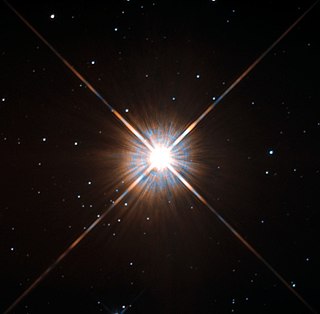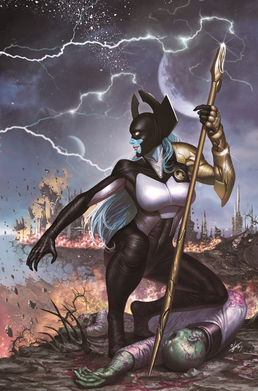
Alpha Centauri is a triple star system in the southern constellation of Centaurus. It consists of three stars: Rigil Kentaurus, Toliman, and Proxima Centauri. Proxima Centauri is the closest star to the Sun at 4.2465 light-years (1.3020 pc).

The Battle of Pharsalus was the decisive battle of Caesar's Civil War fought on 9 August 48 BC near Pharsalus in Central Greece. Julius Caesar and his allies formed up opposite the army of the Roman Republic under the command of Pompey. Pompey had the backing of a majority of Roman senators and his army significantly outnumbered the veteran Caesarian legions.

Marcus Annaeus Lucanus, better known in English as Lucan, was a Roman poet, born in Corduba, Hispania Baetica. He is regarded as one of the outstanding figures of the Imperial Latin period, known in particular for his epic Pharsalia. His youth and speed of composition set him apart from other poets.

Proxima Centauri is the nearest star to Earth after the Sun, located 4.25 light-years away in the southern constellation of Centaurus. This object was discovered in 1915 by Robert Innes. It is a small, low-mass star, too faint to be seen with the naked eye, with an apparent magnitude of 11.13. Its Latin name means the 'nearest [star] of Centaurus'. Proxima Centauri is a member of the Alpha Centauri star system, being identified as component Alpha Centauri C, and is 2.18° to the southwest of the Alpha Centauri AB pair. It is currently 12,950 AU (0.2 ly) from AB, which it orbits with a period of about 550,000 years.

Pharsalia is a town in Chenango County, New York, United States. The population was 593 at the 2010 census. The town was named after Pharsalia, which is a commonly accepted name of the decisive battle in the Great Roman Civil War, where Julius Caesar defeated Pompey in 48 BCE.

In Roman literature, Erichtho is a legendary Thessalian witch who appears in several literary works. She is noted for her horrifying appearance and her impious ways. Her first major role was in the Roman poet Lucan's epic Pharsalia, which details Caesar's Civil War. In the work, Pompey the Great's son, Sextus Pompeius, seeks her, hoping that she will be able to reveal the future concerning the imminent Battle of Pharsalus. In a gruesome scene, she finds a dead body, fills it with potions, and raises it from the dead. The corpse describes a civil war that is plaguing the underworld and delivers a prophecy about what fate lies in store for Pompey and his kin.

De Bello Civili, more commonly referred to as the Pharsalia, is a Roman epic poem written by the poet Lucan, detailing the civil war between Julius Caesar and the forces of the Roman Senate led by Pompey the Great. The poem's title is a reference to the Battle of Pharsalus, which occurred in 48 BC, near Pharsalus, Thessaly, in Northern Greece. Caesar decisively defeated Pompey in this battle, which occupies all of the epic's seventh book. In the early twentieth century, translator J. D. Duff, while arguing that "no reasonable judgment can rank Lucan among the world's great epic poets", notes that the work is notable for Lucan's decision to eschew divine intervention and downplay supernatural occurrences in the events of the story. Scholarly estimation of Lucan's poem and poetry has since changed, as explained by commentator Philip Hardie in 2013: "In recent decades, it has undergone a thorough critical re-evaluation, to re-emerge as a major expression of Neronian politics and aesthetics, a poem whose studied artifice enacts a complex relationship between poetic fantasy and historical reality."

Pharsalia Technologies, Inc. was founded in December 1999, located in Roswell, Georgia, as an emerging company developing network infrastructure products for the Internet market. Led by a team of over 28 software engineers, Pharsalia focused on developing software products for the rapidly escalating content delivery market. The company was headed by Chip Howes, whose team is the inventor of record for over 30 patents in the area of TCP/IP server load balancing, and are credited with the invention of the technology in 1996.
Toutatis or Teutates is a Celtic god who was worshipped primarily in ancient Gaul and Britain. His name means "god of the tribe", and he has been widely interpreted as a tribal protector. According to Roman writer Lucan, the Gauls offered human sacrifices to him.

Hawkins Pharsalia is a historic home located at Ruthsburg, Queen Anne's County, Maryland, United States. It is a 1+1⁄2-story, three-bay, single-pile gambrel-roofed brick dwelling constructed c. 1829, according to a 2015 dendrochronological study by the Oxford Tree-Ring Laboratory. It is one of the best preserved small early-19th century houses in Queen Anne's County, according to the Maryland Historical Trust. Additionally on the property is a brick smokehouse.

Proxima Midnight is a supervillain appearing in American comic books published by Marvel Comics. Created by writer Jonathan Hickman, she first appeared in New Avengers #8. She is a prominent member of the Black Order working for Thanos.

Pharsalia is a genus of long-horned beetles in the family Cerambycidae. There are at least 40 described species in Pharsalia, found mainly in South and Southeast Asia.>

The Black Order is a supervillain team appearing in American comic books published by Marvel Comics. Created by writer Jonathan Hickman, they are a group of alien warriors with various supernatural abilities who serve Thanos. The original iteration, introduced in the 2013 Infinity storyline following a cameo appearance in The New Avengers #8, consists of Ebony Maw, Corvus Glaive, Proxima Midnight, Black Dwarf, and Supergiant, with Black Swan later joining the group as well.

Proxima Centauri b, also referred to as Alpha Centauri Cb, is an exoplanet orbiting within the habitable zone of the red dwarf star Proxima Centauri, which is the closest star to the Sun and part of the larger triple star system Alpha Centauri. It is about 4.2 light-years from Earth in the constellation Centaurus, making it and Proxima d, along with the currently disputed Proxima c, the closest known exoplanets to the Solar System.

Amanita proxima is a species of Amanita from France, Italy, and Spain. It is poisonous.
In Greek mythology, Hesperia or Hesperie, may refer to the following characters and places:
East Pharsalia is a hamlet in Chenango County, New York, United States. The community is 10 miles (16 km) west of Norwich. East Pharsalia had a post office from March 10, 1830 until September 28, 2002; it still has its own ZIP code, 13758.

Proxima Centauri c is a controversial exoplanet candidate whose detection could not be recreated, claimed to be orbiting the red dwarf star Proxima Centauri, which is the closest star to the Sun and part of a triple star system.

BLC1 was a candidate SETI radio signal detected and observed during April and May 2019, and first reported on 18 December 2020, spatially coincident with the direction of the Solar System's closest star, Proxima Centauri.

Proxima Centauri d is a candidate exoplanet orbiting the red dwarf star Proxima Centauri, the closest star to the Sun and part of the Alpha Centauri triple star system. Together with two other planets in the Proxima Centauri system, it is the closest known exoplanet to the Solar System, located approximately 4.2 light-years away in the constellation of Centaurus. The first signs of the exoplanet emerged as a weak 5.15-day signal in radial velocity data taken from the Very Large Telescope during a 2020 study on Proxima b's mass. This signal was formally proposed to be a candidate exoplanet by Faria et al. in a follow-up paper published in February 2022.
















